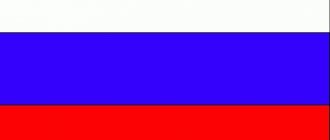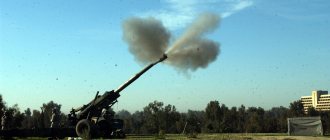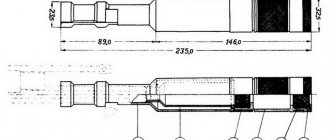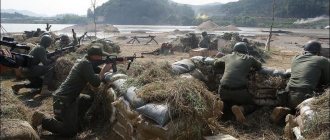Every fifth person is Russian, according to the sociological survey “Levada-Restoration of Constitutional Order” in the territory of South Ossetia not controlled by Tbilisi. Russia argued that it protected its citizens and peacekeepers in South Ossetia and was only responding to Georgian aggression by “forcing it to peace.”
Western media and governments split: Poland and the Baltic countries were inclined to believe that the aggression was started by Russian and South Ossetian armed forces supported by them, and demanded a tough response from the European Union. The “old” EU members, including Germany, called on both sides to de-escalate.
Progress of the war: defeat of Georgia
The main fighting took place in South Ossetia - on the night of August 7-8, Georgia first subjected the capital of South Ossetia, Tskhinvali, to massive artillery fire, after which it attempted to establish control over the republic. On the afternoon of August 8, then Russian President Dmitry Medvedev announced the start of a “peace enforcement operation” in the conflict zone.
Russian tank in Tskhinvali, August 20, 2008
Significant Russian forces were brought into the region. The fighting lasted only five days and ended on August 12 with the defeat of the Georgian army. The Russian military, together with South Ossetian armed forces, ousted Georgian troops from the territory of South Ossetia, which is not under its control, and stopped near Tbilisi.
Victims of conflict and refugees
The Russian military lost 67 people in the August 2008 war, while there were 170 dead on the Georgian side. In total, about 850 people became victims of the five-day conflict, and about two thousand people were injured. Up to 30 thousand Georgians were expelled from South Ossetia and still cannot return to their homes.
The Medvedev-Sarkozy plan and what happened to it
On August 12, 2008, through the mediation of the EU and personally French President Nicolas Sarkozy, the war was stopped. Sarkozy, together with Russian President Dmitry Medvedev, developed a six-point peace plan.
Nicolas Sarkozy (file photo)
The plan envisaged not only a ceasefire, but also the withdrawal of the armed forces to their previous positions, which they occupied before the outbreak of hostilities.
In this regard, the plan is not being implemented: Russia maintains a military presence in both Abkhazia and South Ossetia to this day. Also, the sixth point of the agreement, which, however, the Georgian leader did not sign, is also not being fulfilled - the one that envisaged the beginning of an international discussion of the future status of South Ossetia and Abkhazia.
So who started it first , Georgia or Russia?
The Georgian leadership has always maintained that Russia was the first to start hostilities, and Tbilisi entered the war out of self-defense - after Russian armed forces found themselves on the territory of South Ossetia. Georgian authorities presented printouts of telephone conversations that, in their opinion, indicated that Russian tanks had passed the Roki tunnel and invaded South Ossetia even before the Georgian military attack on Tskhinvali.
This is what the border of the Autonomous Republic of South Ossetia with the rest of Georgia looks like
The independent International Commission to Investigate the Circumstances of the War in the South Caucasus, created by the European Union, brought clarity to this issue. The commission's conclusions were clear: Georgia was the first to begin hostilities.
It all started with artillery shelling on the night of August 8, the capital of South Ossetia, Tskhinvali, and then a ground operation by the Georgian military on the territory of the autonomous republic. The commission did not find sufficient evidence of Georgia's claims that significant Russian forces invaded South Ossetia before August 8.
Europeans accused Russia of provoking the conflict
But Moscow provoked the conflict and is largely responsible for it, said members of the commission created by the EU. An international commission led by Swiss diplomat Heidi Tagliavini cited in its report a number of examples of violations of international law by both parties to the conflict - Moscow and Tbilisi.
Heidi Tagliavini
One of the violations was the fact that before the start of the war with Georgia, Moscow massively issued Russian passports to residents of South Ossetia and Abkhazia. Issuing passports as a preliminary step towards resolving territorial disputes?
On this occasion, the German newspaper Die Welt predicted back in 2010: “What will the future bring? In Ukrainian Crimea, Russian diplomats are distributing Russian passports today. Let the one who thought something bad be ashamed.”
Results of the war for Russia
Russia has turned from a peacemaker in the South Caucasus region into a participant in the conflict on the side of the rebellious Georgian regions. Almost immediately after the end of hostilities, on August 25, 2008, the Kremlin announced recognition of the state independence of South Ossetia and Abkhazia. This step allowed Moscow to strengthen its military presence in the region by creating bases in South Ossetia and Abkhazia. Russia also actually took over both regions for its financial support.
The war with Georgia, which demonstrated, despite the victory of the Russian Federation, the weak technical and material equipment of the Russian troops, is believed to have become the reason for military reform in Russia and large-scale rearmament and re-equipment of the country's armed forces.
Results of the war for Georgia
Defeat in the five-day war with Russia has almost completely destroyed Tbilisi's chances of resolving the conflict with two rebellious Georgian regions in the near future. Since the five-day war, there has been virtually no communication between the Georgian leadership and the authorities of South Ossetia and Abkhazia. But even at the informal level, contacts between residents of border regions have been reduced to a minimum.
Mikheil Saakashvili
The August War marked the beginning of the decline of the political career of the then President of Georgia Mikheil Saakashvili; in the next parliamentary elections in October 2012, Saakashvili’s party was defeated. And a year later, he himself, without waiting for the end of his presidential term, flew abroad.
Consequences for the West
At the Bucharest summit in April 2008, NATO opened up the prospect of membership in the alliance to Georgia. As a number of observers note, this fact, as well as the hope for military assistance from the United States, could have provoked the then Georgian leadership to attempt to forcefully regain control of the lost territories of their autonomous republics.
Context
Russians blame Tbilisi and NATO for the 2008 war with Georgia
According to the survey, “Levada can provoke a terrible conflict,” the Russian Prime Minister said.
He recalled that there are Russian military bases in Abkhazia and South Ossetia. (08/07/2018) Western countries did not intervene in the conflict. The EU and the US still do not recognize South Ossetia and Abkhazia and insist on the territorial integrity of Georgia. Today, the European Union acts as a mediator in the conflict - after the end of the August war, the EU sent an unarmed observer mission to Georgia.
What about today? The parties still blame each other
There are still no diplomatic relations between Georgia and Russia. Tbilisi broke them up soon after Moscow recognized the independence of Abkhazia and South Ossetia, and also left the CIS. Economic cooperation between the two countries has been gradually strengthening in recent years. But their assessment of the war has changed little even ten years later.
Georgian President Giorgi Margvelashvili blamed Russia for the separation of Abkhazia and South Ossetia from Georgia. In turn, Russian Prime Minister Dmitry Medvedev warned Georgia against joining NATO, threatening that otherwise “this could provoke a terrible conflict.” The majority of Russians, according to polls, blame Tbilisi and NATO for the conflict ten years ago.
See also:
Border villages of Georgia: life near barbed wire
Preconditions for war
March
At the beginning of 2008, relations between Russia and Georgia worsened due to the latter's aggressive behavior. Drones were often observed over Abkhazia and Ossetia. During the spring, five of them were destroyed, President Saakashvili blamed Medvedev for this. Saakashvili also said about the Russian bombing of their cities. The Russian Federation responded by accusing it of carrying out preparations for the assault, and therefore increased the number of combat units. The UN Security Council considered the case of one of the downed drones flying over Ossetia.
On March 6, the Russian Federation lifted the ban on conducting trade, economic, and financial relations with Abkhazia, which had been in force since 1996 after the adoption of a corresponding verdict by the heads of the CIS Council. The Ministry of Foreign Affairs negatively assessed the actions of the Russians, declaring support for the separatists and an encroachment on their sovereignty and territory. On April 16, Medvedev made a statement about cooperation with Abkhazia to provide support to the population. He also said that the Saakavishli government is not taking steps to create normal economic relations with the two republics, refuses to conclude agreements with the leaders of Sukhumi and Tskhivali, creating an Ossetian conflict.
April
A reserve of units of the 7th Airborne Division was located near the borders of a potential aggressor. On the 17th, the South Ossetian President warned that the enemy was approaching. The Federation announced the need to increase the number of peacekeepers by transferring its units with armored vehicles.
Minister T. Yakobshvili, when visiting Brussels, noted that he wants to avoid bloodshed, but it is very likely. Russia brings in reinforcements, hiding behind false accusations of aggression.
On May 31, Russia transferred 400 soldiers from the railway units, they were accused of preparing for an invasion, arguing that the railway lines needed to be repaired in order to launch attacks.
Exercises were held in July. Georgia and America were practicing an attack on the territory of the separatists, but Russia did not fight, but was training its units.
Fences on the border
Russian border guards installed barbed wire fences in Didi Khurvaleti, one of the border villages in the Gori region, in the spring of 2012. The fence passed through the village, resulting in four Georgian families on the side not controlled by Tbilisi. Today, only one Vanishvili family remains there. Valya and David Vanishvili do not dare to leave the house where they have lived their whole lives.
Border villages of Georgia: life near barbed wire
Exacerbation
The end of July and the first days of August were characterized by frequent exchanges of fire and shelling of varying intensity. Residents were forced to leave their homes. The South Ossetian Prime Minister announced the urgent evacuation of the civilian population of Tsvinkhval on August 1. Six police officers were seriously injured when terrorists detonated a car bomb.
On the fifth, the Ossetian Foreign Ministry announced its readiness to bomb Gori, Kareli and resorts if the situation escalates.
The Georgian Foreign Ministry drew public attention to the replenishment of the ranks of the separatists with volunteers from the Federation, including Cossacks and Afghans. The country regarded the incident as a signal of an imminent violation of the temporary truce. There was also information about the movement of armored vehicles and other vehicles to the border points. Medvedev spoke about continuing the exercises. The Federation also spoke about supporting Russians living in the conflict area; if necessary, Operation Peace Enforcement will be carried out.
On the seventh, the two Heads of the Republics met, they noted their full readiness. Georgian fighters unsuccessfully attacked the Pris Heights, and information was also received that soldiers were gathering for an offensive. South Ossetia stated that they were going to capture Tsvinhala.
Valya Vanishvili
Georgian pensioner Valya Vanishvili found herself separated from her neighbors in the village of Didi Khurvaleti. She does not dare to move to the Georgian side. Valya complains about the lack of food. In addition, the local store does not accept Georgian lari - only Russian rubles. We have to ask neighbors and relatives to buy food in Georgia and pass it through the fence.
Border villages of Georgia: life near barbed wire
[edit] Losses
[edit] Coalition led by Russia
See also for more details
:
Russian losses during the Five-Day War
The losses of the Russian army were announced at a briefing at the Ministry of Defense on August 13. According to data presented by the Deputy Chief of the General Staff of the Russian Federation, Colonel General Anatoly Nogovitsyn, 74 people were killed, 171 were wounded, 19 were missing. Georgian TV showed two prisoners and one killed Russian pilot on August 9. It is unclear whether the General Staff classifies them as missing in action.[78]
Saakashvili, at a rally in Tbilisi on August 12, claimed that the Georgian army had killed up to 400 Russian soldiers.[79]
The number of people killed among the civilian population of South Ossetia is estimated by Russian and Ossetian authorities at 1,600-2,000 people. This figure was named in the first days of the war and, without a doubt, needs clarification. On August 14, representatives of Human Rights Watch reported that the Tskhinvali Republican Hospital had received 44 killed and 273 wounded since August 6.[80]
There is almost no data on the destroyed military equipment of the Russian side. Only the loss of four aircraft has been officially confirmed - three Su-25 attack aircraft and one Tu-22 bomber (possibly in a reconnaissance modification). In addition, on August 9, Reuters published a photograph of “a part of a Russian plane” shot down in the village of Dzevera near Tskhinvali. The “part” turned out to be the AL-21 engine, which is equipped with the Russian Su-24M front-line bombers. This type of aircraft is not among the losses reported by the Russian Ministry of Defense.[81]
Georgian authorities announced 21 Russian planes and three helicopters shot down, and more than 60 destroyed tanks.[82]
[edit] Georgia
Main article
:
Georgia's losses during the Five-Day War
Georgian official sources give the figures of their losses without dividing them into military personnel and civilians. On August 10, it was reported that 130 Georgian citizens were killed and 1,165 wounded. On August 13, Health Minister Sandro Kvitashvili announced that 175 people had died. Other officials claim "many civilians injured and killed", without specifying the number.[83]
Russian and Ossetian militaries unofficially estimate the irretrievable losses of the Georgian army at hundreds of killed and those who died from wounds. In addition, there are reports of 200 prisoners.[84]
There is almost no data on the losses of military equipment of the Georgian Armed Forces. Apparently, the number of destroyed tanks and infantry fighting vehicles is in the dozens. A lot of military equipment was abandoned during the retreat of the Georgian troops: for example, journalists counted six Czech-made Dana self-propelled artillery mounts on the Gori-Tbilisi highway.[85]
The Georgian fleet was almost completely destroyed: two boats were lost in naval battles, several more (up to 10) were destroyed from the air and sunk by Russian paratroopers at the piers in Poti.[86]
Georgian police post
In principle, anyone, including tourists, can visit the so-called administrative border line, beyond which South Ossetia begins. To do this, you must notify the Georgian Ministry of Internal Affairs about your trip in advance. For security reasons, movement on this land is only possible accompanied by representatives of the Georgian Ministry of Internal Affairs. Local villagers are also obliged to warn about their movements.
Border villages of Georgia: life near barbed wire
PLAN FOR THE CAPTURE OF ABKHAZIA – OPERATION “ROCK”
According to the plan of the Georgian side, during the first stage of the operation to seize the territory of Abkhazia, planned for August 15, 2008, under the code name “Rock,” a group of Abkhaz troops located in the eastern part of the country would launch a combined strike from the upper part of the Kodori Gorge, as well as from the border The Inguri River along the strategic highway Zugdidi - Gali - Sukhum with the landing of amphibious assault in Ochamchira and Sukhum was completely destroyed. The Russian peacekeepers stationed at that time along the demarcation line of the parties in the so-called security zone were also defeated. And at the second stage of the operation, during the development of the offensive in the northwestern direction, along the Sukhum - Gudauta - Gagra - Psou highway and the successive landing of tactical amphibious assault forces in Gudauta, Pitsunda, Gagra, Georgian troops reached the state border with Russia along the Psou River. The passes along the Main Caucasus Range on the Abkhaz section of the Georgian-Russian border, which were in the hands of the Abkhaz, would be captured with the help of special forces units and mountain rifle units. Thus, the republic would be cut off from outside help. Subsequently, the Georgians envisioned “cleaning up” the entire Abkhaz territory, establishing full control over the occupied area and returning about 300 thousand Georgian refugees to their former place of residence.
It is not for nothing that the Georgians created a group of troops of various security forces here with a total number of up to 6 thousand people. Its basis was the fully combat-ready and mobilized 5th Infantry Brigade. It was armed with Msta-S and D-30 howitzers, BM-21 Grad MLRS, an Israeli-made Lar MLRS battery of 160 mm caliber and a missile launch range of up to 45 kilometers. It was fully deployed in advance from its permanent deployment point in Batumi (Adjara) and deployed to its full strength. In addition, special forces units from the special forces brigade of the Georgian Ministry of Internal Affairs were stationed here - two companies of “specialists” and one assault company. Reconnaissance and sabotage groups (RDGs), created by the Georgian Ministry of State Security from militants of the illegal armed groups “White Legion” and “Forest Brothers”, also operated in this area. Their total number was about 200 people. RDG, according to the head of the intelligence department of the General Staff of the Armed Forces of the Republic of Abkhazia (General Staff of the Armed Forces of the Republic of Abkhazia) Colonel Beslan Tsvizhba and his deputy - chief of staff of the intelligence department of the General Staff of the Armed Forces of the Republic of Abkhazia Colonel Sergei Arshba, counted 30, 50 and 60 people depending on the volume of tasks being solved each.
Barbed wire in the yard
In the village of Gugutiantkari in the Gori region, Russian border guards installed barbed wire in the spring of 2013. Here it passes through houses and courtyards. Thus, the house sometimes remains on one side, and the adjacent garden on the other. According to the Ossetian side, these barriers are “engineering barriers along the perimeter of the state border of the Republic of South Ossetia.”
Border villages of Georgia: life near barbed wire
Main events
Further events developed according to the following scenario:
- When the Georgians attacked the capital of South Ossetia, Russia intervened in the Georgian conflict by sending troops and armored vehicles through the Roki Tunnel towards the capital. Aviation subjected the enemy to air attack along the entire front line, subsequently destroying all enemy airfields.
- On August 9, Saakashvili declared martial law and mobilization to stabilize the situation in North Ossetia. The Russian GRU and FSB targeted Georgian positions and radar reconnaissance targets. Russian aviation dropped bombs on the cities of Senaki, Poti and Gori. The Russian fleet has begun patrolling off the coast of Abkhazia. The arriving reinforcements fought with the Georgian military in the Zar direction. Later, General V. Bondarev made a statement about the liberation of Tskhinval.
- On August 10, Russian artillery and aircraft shell enemy positions in the capital of South Ossetia. The Georgian Ministry of Internal Affairs announces the withdrawal of combat units from the city. Two corridors have been organized for the evacuation of refugees. Gori was struck again, as well as the Tbilisi aircraft plant.
- On August 11, Russian aviation fought, firing on the suburbs of the capital, and occupied a base in Senaki. France has proposed a plan to stabilize the conflict in Georgia, involving the withdrawal of all troops from the area of conflict. President Medvedev agreed to a truce.
- On August 12, Russia and France agreed on a settlement plan. The President of the Russian Federation announced the end of the operation to force Georgia to peace. The Caucasian country announced its agreement to sign the proposed document, excluding the clause on the autonomy of South Ossetia.
- On August 22, the Russian Federation completely withdrew its troops from Georgian territory.
Reluctant defector
A lost cow ended up in territory controlled by the Russian military and Ossetians. The owner may have difficulty returning her. After all, every crossing to the “foreign” side can result in detention and a fine for so-called illegal border crossing. In 2013, about a hundred people were already detained.
Border villages of Georgia: life near barbed wire
When the toilet is located on “foreign” territory
This house used to be the pride of the Gugutishvili family from the village of Gugutiantkari. Its owners live in the school building after the war. In April 2013, barbed wire appeared in this village. After long negotiations, the family managed to gain the opportunity to enter the house, but their garden and toilet are already located on “foreign” territory. Every trip to the toilet can result in detention and a fine.
Border villages of Georgia: life near barbed wire
Beginning of the military conflict
On the night of June 15, 2008, South Ossetia put its army on high alert, which was caused by a three-hour artillery shelling of Tskhinvali. The Ossetian side returned fire. The OSCE mission was injured in the incident, whose car came under fire.
According to the Ossetian side, shortly before the start of the shelling, Georgian military equipment was pulled to the Georgian village of Ergneti, located on the border with South Ossetia. Another 10 military trucks were spotted on the way to the village of Nikozi, the location of elite Georgian units trained with the assistance of American specialists. Later they participated in the August events.
The shelling of Tskhinvali continued on July 4, but this time Russia intervened in the situation. According to Moscow, the further development of hostilities was prevented by Russian aircraft, which appeared in the skies over South Ossetia on July 8.
The next element of the strategy of mutual deterrence was the maneuvers carried out in mid-July near the Ossetian-Georgian border. First, Russia involved about 8 thousand people in the military exercises “Caucasus-2008”, and then Georgia, together with the United States, involved more than 2 thousand troops in the exercises with the symbolic name “Immediate Response-2008”. A couple of weeks later, skirmishes continued between the Ossetian and Georgian sides.
On August 7, Georgia and South Ossetia agreed on a ceasefire, Saakashvili declared his readiness for any peace negotiations. Following this, Georgian peacekeepers and observers from the OSCE unexpectedly left their posts.
On the night of August 8, Georgian artillery began shelling Tskhinvali, and at the same time troops and armored vehicles advanced towards the city. The Georgian command planned to first destroy two Russian peacekeeping battalions in Tskhinvali, and then blockade and capture the city. The attackers' further route ran to the north, where it was necessary to destroy the Roki tunnel between North and South Ossetia.
By the beginning of hostilities, Georgia had gathered about 7 thousand people, about 180 tanks and about 400 guns and multiple launch rocket systems to the border. In South Ossetia, about 3 thousand people were on combat readiness, another 15 thousand were in reserve. The situation was approximately the same in Abkhazia.
Green Gate
The green fence near the village of Ditsi in the Gori region has already stretched for 4 kilometers. Work on its construction has not yet been completed. It is here, according to official Tbilisi, that the fence extends up to 300 meters deep into the territory controlled by the Georgian authorities. Gates have already been installed on one of the bypass roads. On the other side you can see a sign with the inscription “Republic of South Ossetia”.
Border villages of Georgia: life near barbed wire
Who started this conflict, the opinions of the warring parties
To this day, the conflicting parties blame each other for starting this conflict. To figure out who is really to blame, you need to hear all sides of the conflict and draw conclusions from this:
- The opinion of the Georgian government is unequivocal and unshakable. They claim that this conflict was started by the South Ossetian side, which entered into a conspiracy with Russia and carried out a series of provocations. According to Georgia, their invasion of the territory of South Ossetia was due to the fact that the Georgian military managed to intercept a secret telephone conversation in which information “came up” that Russian troops had already invaded the territory of South Ossetia on August 7;
- Russia's position on this issue was clearly voiced by Russian Foreign Minister Sergei Lavrov. He stated that the only reason for the entry of Russian troops into the territory of South Ossetia was Georgia's military aggression against South Ossetia. The consequences of Georgian aggression were 30 thousand refugees, the death of civilians in South Ossetia, and the death of Russian peacekeepers. All actions of the Georgian army on the territory of South Ossetia were qualified by the Russian side as full-scale genocide. According to Russia, not a single country in the world will remain indifferent after an attack on its peacekeepers and civilians who find themselves on the territory of South Ossetia, therefore the entry of Russian troops into the territory of South Ossetia is natural and justified;
- Since Europe was also interested in finding out who is to blame for the Russian-Georgian conflict, an International Independent Commission was created, headed by Swiss diplomat Heidi Tagliavini. This commission found Georgia guilty of starting the conflict in South Ossetia, since it was Georgia that began the bombing of Tskhinvali. It was noted that the Georgian attack was launched after multiple acts of provocation on the part of South Ossetia. The Russian side has also been accused of numerous violations of international rights.
Gori
Gori, the center of the Shida Kartli region and Stalin's birthplace, was hit hardest during the 2008 war. From here it is 80 kilometers to Tbilisi, and about 30 kilometers to the so-called administrative border line. The city, completely rebuilt after the conflict, attracts many foreign tourists. But its residents complain of high unemployment and hope for normalization of relations with Russia.
Border villages of Georgia: life near barbed wire
Truce
On the twelfth, President Medvedev made a statement about the winding down of the peace enforcement operation. He said that the population was safe, the aggressor had been stopped, and the army had been defeated. If the situation repeats, a decision will be made to destroy it.
During the visit of the French President, demands were drawn up to resolve the conflict:
- Complete cessation of aggression;
- Unimpeded delivery of humanitarian aid;
- Recall of troops;
- Prohibition on the use of force;
- Return of the Russians to their original positions;
- Conducting negotiations on the status of the Republics.
Afterwards, the French President met with Saakashvili.
Thirteenth
Reports continue to come in about the advance of peacekeeping troops. Columns of armored vehicles that occupied Gori moved towards Tbilisi. Lavrov commented, saying that the equipment was removed from the region to ensure the protection of civilians. He also denied the presence of tanks; there were armored personnel carriers there. The minister denies that the cars were in Poti.
The Georgian side agreed to accept the demands, but after editing the last paragraph. Sarkozy supported the need for amendments. He obtained Medvedev's permission to change the context, removing the ambiguous interpretation.
Fourteenth
Gori is shelled, the Russians deny any involvement, refuting accusations of capture. During the day, control was transferred to the local police; allied forces will leave it in 2-3 days.
The fifteenth
Uvarov announced an increase in the peacekeeping contingent, and military equipment will also be transferred. According to Uvarov, conclusions were drawn and it is necessary to prevent a repeat of 2008, the war with Georgia, this should not happen again.
Sixteenth
The settlement plan was signed by all participants. The event known as the "Five Day War" was over.
Shavshvebi refugee settlement
Villages of one-story houses with red or blue roofs can be found along the road from Tbilisi to western Georgia. Since December 2008, Shavshvebi has been home to 563 people who fled their homes during the Russian-Georgian war. According to official data, a total of 24,700 people on the Georgian side lost their homes as a result of the 2008 war, of which slightly more than half live in new settlements.
Border villages of Georgia: life near barbed wire
War crimes committed during the conflict in South Ossetia
Since the Russian and Georgian authorities accuse each other of various crimes and ethnic cleansing, one should listen to the opinions of independent experts, since each side will protect itself while denigrating the actions of the enemy.
The human rights organization Amnesty International became seriously interested in this conflict; in 2008, while all the consequences of the military conflict were still visible and fresh in the memory of the local population. Already in November 2008, this association published an official report, which detailed a large part of the war crimes. Here are the main findings from this report:
- When the Georgian army stormed Tskhinvali, its soldiers carried out numerous attacks on civilians, leaving dozens of them dead and hundreds seriously injured. In addition, the city's infrastructure was significantly damaged, which was not a military facility (schools, hospitals, etc.);
- Tskhinvali suffered the most extensive destruction from the use of Georgian Grad multiple launch rocket systems, which have an extremely low accuracy parameter;
- During the military conflict, Russian aviation carried out about 75 combat missions. It is these sorties that the Georgian side accuses of causing enormous harm to the civilian population. According to the results of the inspection, villages and towns suffered little damage as a result of air strikes; several streets and some individual houses were destroyed. Naturally, the people who were in them also suffered;
- Sometimes the Russian military, attacking Georgian settlements, caused harm to civilians. To this, the Russian side responds that all attacks on civilians are provoked by their aggressive behavior;
- The report noted that the discipline of Russian military personnel differed significantly from the behavior of Ossetian fighters and militias, who often behaved like looters. Georgian civilians interviewed confirm that the Russian military rarely behaved undisciplinedly;
- South Ossetian soldiers were seen committing serious war crimes on Georgian territory. These are illegal killings, arson, beatings, threats, rape and robberies that were committed by units and militias of South Ossetia.
Amnesty International calls on parties to investigate every war crime and punish those responsible.
The military campaign in Georgia in 2008 showed that the Russian army is in urgent need of reform, since many branches of the military were unable to act coherently within the framework of a separate combat operation. Russia's combat losses were incomparable with the scale of this military conflict.
Galina Kelekhsaeva hopes to return to her home
Galina Kelekhsaeva’s optimism and cordiality can be envied. Because of the August War, she and her family were forced to leave their native village of Didi Liakhvi. She is happy about the arrival of the guests, worries that she cannot receive them properly, and at parting she is encouraging: “We will definitely return to our homes, for some reason I believe in it. And the most important thing is that there is peace. Yes, we lost everything, but we survived."
Border villages of Georgia: life near barbed wire
Content
- 1 Course of events 1.1 August 7, 2008
- 1.2 August 8, 2008
- 1.3 August 9, 2008
- 1.4 August 10, 2008
- 1.5 August 11, 2008
- 1.6 August 12, 2008
- 2.1 August 13, 2008
- 3.1 Georgia
- 4.1 Coalition led by Russia
- 5.1 Coalition led by Russia
Refugee with 22 years of experience Nazi Beruashvili
Nazi Beruashvili is originally from Tskhinvali, but during the first Georgian-Ossetian war in the early 1990s, she had to flee from her hometown to the village of Eredvi. The 2008 war forced her to leave her home in Eredvi. Nazi Beruashvili proudly shows off his farm. A refugee with 22 years of experience no longer believes in returning to her native land.
Border villages of Georgia: life near barbed wire
ARMED FORCES OF THE REPUBLIC OF ABKHAZIA
By the beginning of active hostilities, the armed forces of the Republic of Abkhazia numbered more than 6 thousand personnel. This is if we take units and units of constant readiness. But according to the combat alert, their number due to the mobilization of reservists in the period from several hours to a maximum of two days could be about 18-20 thousand people aged from 18 to 60 years. The size of the army of Abkhazia could increase significantly due to the arrival of volunteers from the republics of the North Caucasus, from Kuban, Don and envoys from the foreign Abkhaz diaspora living in Asia Minor, the Middle East and Europe. Taking into account such replenishment, the strength of the Abkhaz army could reach 30 thousand people.
Abkhazians keep small arms at home. So they are ready to go on alert almost immediately. Reservists receive more serious weapons and military equipment, depending on their military specialty, in the shortest possible time in the places designated for them. Therefore, from the very beginning it was clear that there could not be an easy walk for the Georgians on Abkhazian land, just as there could not be a sudden attack. Abkhaz military intelligence knew about the enemy’s preparations several months in advance.
Among the volunteers, the Kuban and Don Cossacks are, of course, considered the most prepared. As the adviser to the President of the Republic of Abkhazia on Cossack issues, ataman of the Sukhumi special department of the Kuban Cossack army, Cossack Colonel Valery Vasilchenko, noted, if an urgent need arose, the Kuban people were ready to deploy up to 15 thousand people. Moreover, unregistered Cossacks, not officially included in the state register and not in service. The Cossacks living in Abkhazia, and this is more than 600 people, were ready to take arms at the first call to defend the republic. During the events of August 2008, many of them took part in the liberation of the upper part of the Kodori Gorge, while others were ready to come to the aid of their comrades and reinforce them if necessary.
It should be noted that the preparation of Georgian troops for fighting in the mountains was carried out by instructors and advisers from the USA, Israel, Ukraine, France, Turkey, Pakistan, Saudi Arabia and other countries. Mostly representatives of the special services and those who served in the special forces of the above-mentioned countries worked here.
Over the course of a year and a half, the enemy created an extensive network of engineering structures in the Upper Kodori. The Georgians, according to Colonel S. Arshba, equipped during this time 5-6 intermediate and one main line of mobile defense. The only passage through the bridge to the upper part of the Kodori Gorge in the Kuabchar area was mined. The sheer cliff above the abyss and the road leading towards the Main Caucasus Range was also mined. About 400 kg of TNT were placed here. As the Chief of the General Staff of the RA Armed Forces - First Deputy Minister of Defense of the Republic of Abkhazia, Colonel General Anatoly Zaitsev, said, in the Upper Kodori region the enemy created a system of crossfire and fire bags. Company and platoon strongholds and outposts were equipped along the routes of a possible Abkhaz offensive. Anti-personnel minefields have also been created. To monitor the progress of preparation and creation of fortifications and provide practical assistance at the work site, a representative of the engineering department of the Georgian Ministry of Defense was constantly present.










